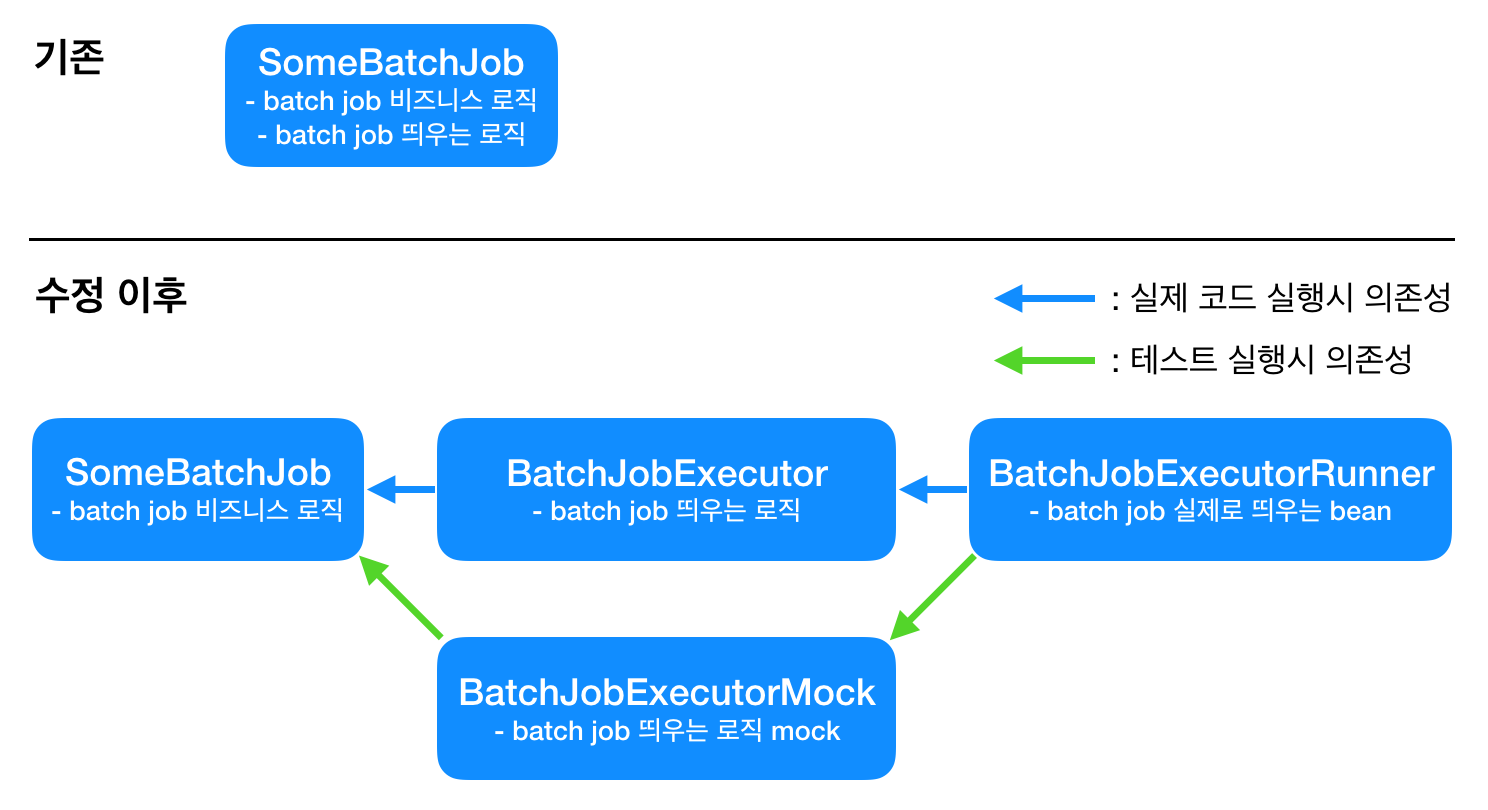개요
이번 글은 테스트를 돌릴 때 @PostConstruct와 @PreDestroy hook을 비활성화하는 방법에 대한 글이다.
문제 상황
아래와 같이 batch job을 @PostConstruct과 ScheduledExecutorService를 활용하여 띄운다고 해보자.1
2
3
4
5
6
7
8
9
10
11
12
13
14
15
16
17
18
19
20
21@Component
class SomeBatchJob {
private val executor = Executors.newSingleThreadScheduledExecutor()
@PostConstruct
fun start() {
executor.scheduleWithFixedDelay({
run()
}, 0, 60L, TimeUnit.MINUTES)
}
fun run() {
// do some batch job
}
@PreDestroy
fun end() {
executor.shutdown()
executor.awaitTermination(60L, TimeUnit.MINUTES)
}
}
이제 이 batch job의 로직을 테스트하고 싶다. 그러면 @PostConstruct에 의해 실행되는 batch job이 테스트에 영향을 미칠 수 있기 때문에 당연히 이를 비활성화하고 싶을 것이다.
내가 가장 먼저 떠올린 방법은 여태까지 해왔던 대로 @Primary 어노테이션을 사용해서 bean을 덮어쓰는 것이였다. 그래서 SomeBatchJob을 상속받은 SomeBatchJobMock을 만들어 start()와 end()가 아무런 작업도 하지 않도록 override한 후 테스트 configuration에 @Primary 어노테이션을 활용해 bean을 덮어썼다.1
2
3
4
5@Component
class SomeBatchJobMock : SomeBatchJob() {
override fun start() {}
override fun end() {}
}1
2
3
4
5
6
7
8@Configuration
class TestConfiguration {
@Primary
@Bean
fun someBatchJobMock(): SomeBatchJob {
return SomeBatchJobMock()
}
}1
2
3
4
5
6
7
8
9
10@RunWith(SpringRunner::class)
@SpringBootTest(
classes = [TestConfiguration::class]
)
class SomeBatchJobTest {
@Test
fun test() {
// test logic here
}
}
하지만 테스트를 돌려보면 SomeBatchJob.start()가 실행되는 것을 확인할 수 있다. 어떻게 된 일일까?
@Primary 어노테이션 작동 방식
필자는 이것 때문에 굉장한 삽질을 했는데, 결국 이는 @Primary 어노테이션의 작동 방식을 오해하고 있었기 때문이었다. 결론부터 말하자면 @Primary 어노테이션은 동일한 타입의 다른 bean을 덮어쓰는 것이 아니다. Bean scanning에 의해 발견되는 모든 bean은 @Primary 어노테이션과는 무관하게 일단 ApplicationContext에 등록이 된다. 이 때문에 SomeBatchJob과 SomeBatchJobMock의 start()가 둘 다 실행된 것이다. 이는 SomeBatchJob과 SomeBatchJobMock의 start()에 break point를 걸고 디버깅 모드로 실행해서 알게 된 사실이다.
그러면 @Primary 어노테이션의 역할은 무엇일까? 이는 docs를 보면 금방 알 수 있다.
Indicates that a bean should be given preference when multiple candidates are qualified to autowire a single-valued dependency. If exactly one ‘primary’ bean exists among the candidates, it will be the autowired value.
즉, 위의 예제에 대입해서 설명하면, 다른 bean에서 SomeBatchJob 타입의 bean을 주입받으면 항상 SomeBatchJobMock이 주입된다는 의미이다. 따라서 당연히 @Primary 어노테이션으로는 @PostConstruct hook을 막을 수는 없다.
Dependency를 바꿔서 해결
일단 bean이 등록이 되면 @PostConstruct는 반드시 실행이 된다. 따라서 mock 하려는 기능은 애초에 bean scanning 단계에서 걸리지 않는 bean에 있거나, bean scanning에 걸린다면 @PostConstruct 어노테이션이 붙은 메소드 안에 있으면 안 된다.
그러면 어떻게 해야할까? 크게 두 가지 방법이 있다.
- 기존의 bean은 bean scanning에 걸리지 않게 설정하고,
start()와end()를 아무 동작도 하지 않도록 override한 mock bean을 하나 만들어 테스트에서 사용한다. @PostConstruct를 사용하지 않는다. 대신, 해당 bean을 주입받은 다른 bean에서start()와end()를 호출한다. 즉,A.a()를 mock 하려면A를 주입받는B라는 bean을 만들고@PostConstruct가 붙은B.b()에서A.a()를 호출한다. 이후 테스트에서는B.b()를 아무 동작도 하지 않도록 mock 한다.
필자는 이미 수많은 테스트가 작성된 프로젝트에서 작업을 하고 있었기 때문에, 테스트 설정을 바꾸는 1번 대신 2번 방법을 선택했다. 최종적으로 바뀐 의존성을 먼저 보여주자면 아래 그림과 같다.

원래는 SomeBatchJob의 start()에 batch job을 띄우는 로직이 있었다. 근데 SomeBatchJob을 mock 할 수는 없다. 왜냐면 만약 SomeBatchJob에 다른 의존성이 있을 경우 SomeBatchJob을 mock 하면 다른 의존성이 주입이 안 되면서 run() 메소드가 제대로 돌아가지 않을 것이기 때문이다. 따라서 run() 로직에 대해 제대로 테스트를 돌릴 수 없을 것이다.
그래서 일단 테스트 할 batch job의 비즈니스 로직과 “batch job을 띄운다”는 로직을 서로 다른 bean이 가지도록 분리시켰다. start()와 end()는 BatchJobExecutor의 executeJobs()와 shutdownJobs()로 로직을 옮기고 BatchJobExecutor가 SomeBatchJob을 주입받아 executeJobs()에서 SomeBatchJob을 띄우도록 했다.1
2
3interface BatchJob {
fun run()
}1
2
3
4
5
6@Component
class SomeBatchJob : BatchJob {
override fun run() {
// do some batch job
}
}1
2
3
4
5
6
7
8
9
10
11
12
13
14
15
16
17
18
19
20@Component
class BatchJobExecutor(
private val batchJobs: List<BatchJob>
) {
private val executor = Executors.newSingleThreadScheduledExecutor()
fun executeJobs() {
batchJobs.forEach {
executor.scheduleWithFixedDelay({
it.run()
}, 0, 60L, TimeUnit.MINUTES)
}
}
@PreDestroy
fun shutdownJobs() {
executor.shutdown()
executor.awaitTermination(60L, TimeUnit.MINUTES)
}
}
문제는 BatchJobExecutor.executeJobs()에다가 @PostConstruct를 달아도 안 된다. Mock을 한다고 해도 bean이 ApplicationContext에 등록돼서 job이 뜰 것이기 때문이다.
그래서 bean을 하나 더 만들었다. BatchJobExecutor을 주입받아서 executeJobs()를 실행시켜주는 BatchJobExecutorRunner을 새로 정의했다. BatchJobExecutorRunner는 생성될 때 BatchJobExecutor.executeJobs()를 호출해준다.1
2
3
4
5
6
7
8@SpringBootApplication
class SampleApplication {
@Bean
fun batchJobExecutorRunner(batchJobExecutor: BatchJobExecutor): BatchJobExecutor {
batchJobExecutor.executeJobs()
return batchJobExecutor
}
}
이제 테스트를 돌릴 때 BatchJobExecutor을 mock 해주고 executeJobs()와 shutdownJobs()를 아무 동작도 하지 않도록 override 해주면 batch job이 뜨지 않는다.1
2
3
4
5
6
7@Component
class BatchJobExecutorMock(
private val batchJobs: List<BatchJob>
) : BatchJobExecutor(batchJobs) {
override fun executeJobs() {}
override fun shutdownJobs() {}
}1
2
3
4
5
6
7
8@Configuration
class TestConfiguration {
@Primary
@Bean
fun batchJobExecutorMock(batchJobExecutorMock: BatchJobExecutorMock): BatchJobExecutor {
return batchJobExecutorMock
}
}1
2
3
4
5
6
7
8
9
10@RunWith(SpringRunner::class)
@SpringBootTest(
classes = [TestConfiguration::class]
)
class SomeBatchJobTest {
@Test
fun test() {
// test logic here
}
}
결론
@Primary는 bean을 덮어쓰는게 아니다.@Primary의 존재 여부와는 관계 없이 모든 bean은 우선 bean scanning을 통해ApplicationContext에 등록된다.- 특정 타입의 bean을 주입할 때 같은 타입의 bean이 여러 개 있을 경우,
@Primary어노테이션이 붙은 bean이 우선순위를 가지고 주입된다. - 프레임워크가 평소에 잘 돌아간다고 아무 생각 없이 막 갖다 쓰지 말고 docs 한 번쯤은 읽어보자.